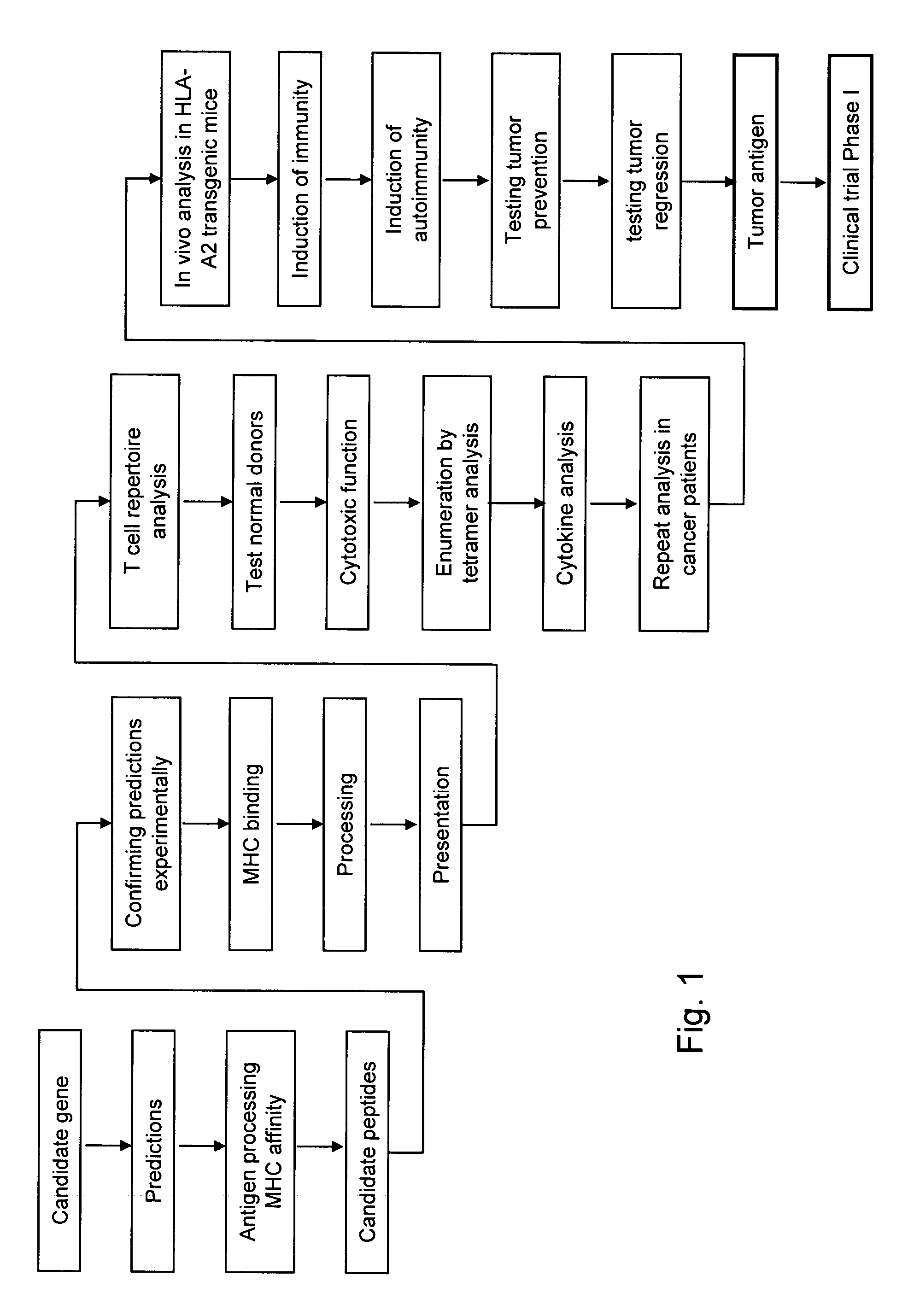Human anti-cancer immunotherapy
a technology of immunotherapy and effector cells, applied in the field of human immunotherapy, can solve the problems of relapse and gvhd remaining significant obstacles, the development of cellular immunotherapy with effector cells of defined specificity and function has proved more challenging, and the limitations of fusion proteins as target antigens
- Summary
- Abstract
- Description
- Claims
- Application Information
AI Technical Summary
Benefits of technology
Problems solved by technology
Method used
Image
Examples
example 1
Epitope Deduction
[0302] Clinically successful specific cancer immunotherapy depends on the identification of tumor regression antigens. Prior to the present disclosure, tumor antigens have been identified by analyzing either the T cell or antibody responses of cancer patients against autologous cancer cells. The unveiling of the human genome, improved bioinformatics tools, and optimized immunological analytical tools have made it possible to screen any given protein for immunogenic epitopes. The results herein demonstrate that based on these advancements, a new class of tumor antigens can be identified by directly linking cancer genomics to cancer immunology and immunotherapy.
[0303] The discovery of these novel tumor antigens are based largely on the method depicted in FIG. 1; namely, the deduction of peptide MHC epitopes from genes having broad overexpression in cancer and known crucial roles in tumor growth and development.
[0304] The method of epitope deduction, otherwise known...
example 2
Leukemia Specific CD8+ T Cells
[0313] It has been observed that patients with AML or CML in remission following alloSCT (allogeneic stem cell transplantation) exhibited significant numbers of peripheral blood cytotoxic T lymphocytes (CTL) that recognize varying combinations of epitopes derived from leukemia-associated antigens. Prior to transplantation or in normal individuals, CD8+ T cells specific for these antigens are rare.
[0314] In order to assess the repertoire and function of CD8+ T cell responses after transplantation and determine whether activated donor lymphocyte infusions (aDLI) augments the proliferative and cytoproductive function of these cells in vivo, a method of epitope deduction was used to identify a panel of candidate peptide antigens. The candidate peptide antigens were then screened with patient T cells for reactivity to these antigens using peptide / MHC tetramer technology. Samples were obtained from a total of 12 patients with AML or CML before or after allo...
example 3
HoxA9 and Meis1 as Tumor-Associated Antigens Recognized by CTL
[0318] HoxA9 and Meis1 were evaluated as candidate leukemia-associated antigens for two reasons: (i) they are each highly co-expressed in most cases of AML, CML, and MDS (a notable exception is M3 AML), and (ii) each plays a defining and collaborative role in the induction of AML. HoxA9 is considered to be the single most highly correlated gene (out of >6,000) for poor prognosis in human AML and is essential for MLL-dependent leukemogenesis in vivo. HoxA9 cooperatively binds DNA with Meis1 such that only the co-overexpression of both transcription factors results in rapid leukemic transformation of primitive hemopoietic cells. HoxA9 and Meis1 are also normally expressed in bone marrow but otherwise have limited post-natal expression. In 29 primary AML samples tested, it was observed HoxA9 expression in 50% of samples and Meis1 expression in 72% by RT-PCR, although only 2 samples were positive for MLL translocations. Thus...
PUM
| Property | Measurement | Unit |
|---|---|---|
| Capacitance | aaaaa | aaaaa |
| Capacitance | aaaaa | aaaaa |
| Capacitance | aaaaa | aaaaa |
Abstract
Description
Claims
Application Information
 Login to View More
Login to View More - R&D
- Intellectual Property
- Life Sciences
- Materials
- Tech Scout
- Unparalleled Data Quality
- Higher Quality Content
- 60% Fewer Hallucinations
Browse by: Latest US Patents, China's latest patents, Technical Efficacy Thesaurus, Application Domain, Technology Topic, Popular Technical Reports.
© 2025 PatSnap. All rights reserved.Legal|Privacy policy|Modern Slavery Act Transparency Statement|Sitemap|About US| Contact US: help@patsnap.com



